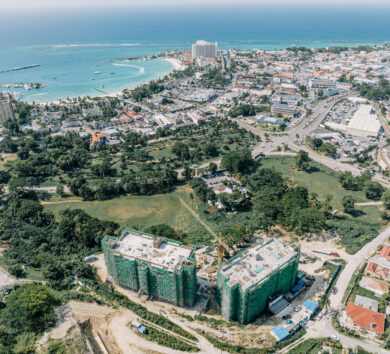

Jamaica’s economic growth at least in the short term looks anaemic, nevertheless both fiscal and monetary quantitative performance indicators are good surmises the Economic Programme Oversight Committee (EPOC) which is headed by JMMB Group CEO , Keith Duncan.
Speaking at a press conference on Friday, Duncan noted that total revenue and grants of J$ 301 billion for April to July 2024 outperformed the budget projections by J$12.9 billion with contributions of J$270.8 billion from tax revenue and $27. 5 billion from non-tax revenue.
This outturn represents a year-over-year increase of $21.3 billion compared to April to July 2023, reflecting ongoing improvements in domestic economic activities, though at a slower pace, along with gains in corporate profits and labour market conditions.
Attention must be paid to tax revenue which surpassed the budget by $3.7 billion for the review period. This was primarily due to stronger than expected total income and profits, which was $5.5 billion higher than budget , as other companies and tax on interest were ahead by $2.8 billion and $2.3 billion respectively.

However, this positive impact was tempered by the lower than projected receipts from production and consumption, and international trade. Notably, travel tax with inflows of $9.5 billion was $2.1 billion behind target reflecting slower than projected visitor arrivals.
Non-tax revenue, which exceeded the budget by $7.0 billion was positively impacted by the drawdown of the Government of Jamaica’s insurance policies with the Caribbean Catastrophe Risk Insurance Facility (CCRIF) .
On the expenditure side, above-the-line spending, which came to $336.2 billion was $6.2 billion below the budget but 12.4 per cent higher than the total spending for April to July 2023. The shortfall relative to budget primarily reflected lower than anticipated recurrent spending.
For the review period, the Central Government operations resulted in a fiscal deficit of $34.3 billion compared to a budgeted deficit of $53.4 billion.
This deficit was however higher than the $18.4 billion deficit recorded for April to July 2023. A primary surplus of $21.7 billion was generated for the review period. This exceeded the budgeted surplus of $2.3 billion but was $12.9 billion lower than the surplus reported for April to July 2023.

Duncan declared: “ Given Jamaica’s recent macroeconomic developments, a supplementary budget is expected to be presented to Parliament by the end of September 2024. This budget will incorporate the fiscal impact of Hurricane Beryl, revenue measures announced by the Minister of Finance during his budget presentation in March 2024, and other emerging factors that may influence Jamaica’s fiscal outlook.”
There has been a steadying of the inflation rate with it remaining at 5.1 per cent for July 2024, the fifth consecutive month that inflation has remained within the Bank of Jamaica’s 4.0 per cent to 6.0 per cent target range.
Many breathed a sigh of relief when the Bank of Jamaica’s Monetary Policy Committee took the decision to reduce the policy rate by 25 basis points to 6.75 per cent. It had remained unchanged at 7.0 per cent since November 2022.
The Monetary Policy Committee concluded that inflation is becoming more anchored in the BOJ’s target range of 4-6 per cent and reflects its assessment that the prevailing economic environment is conducive to a further cautious easing of its monetary policy stance. The Bank of Jamaica’s next policy announcement is scheduled for September 30, 2024.
Jamaica’s net international reserves stood at US$5 billion at the end of July 2024.

The foreign exchange market has remained relatively stable since the start of the year. The exchange rate at the end of August this year, stood at J$158.09 to US$1.00, a depreciation of J$1.63 compared to the end of June, 2024 and a year-over-year depreciation of 1.64 per cent against the US dollar.
There was an increase in the depreciation rate for July to August 2024 relative to the same two months in 2023.
Remittances continue to decline with net remittance inflows of US$1 billion recorded for April to July 2024, a decline of US$7.2 million compared to the same period in the previous fiscal year. This was driven by a US$8.9 million reduction in total remittance inflows, which was partially offset by a US$1.8 million decrease in remittance outflows
The economy is flat with marginal growth being the order of the day. Hurricane Beryl has made matters worse. The Planning Institute of Jamaica (PIOJ) estimated for the April to June 2024 quarter, real GDP was relatively flat at 0.1 per cent compared to the same period in 2023.
This as largely driven by a flat outturn of 0.1 per cent in the Homeland Restaurant industry, a key driver of Jamaica’s growth post COVID. Construction continues to decline. The mining and quarrying industry has normalised while agriculture, with a growth rate of 2.7 per cent continues to perform well this quarter. However, due to the impact of Beryl, a decline is expected.
The PIOJ also noted that the short-term outlook for the July-September 2024 quarter points to a contraction in output, primarily due to the impact of Hurricane Beryl on sectors such as electricity and water, and agriculture.

However, the full fiscal year 2024/25 projection is for lower than budgeted growth of 1.8 per cent by the Government of Jamaica with growth estimates ranging from -1.0 per cent to 1.0 per cent, largely dependent on the pace of recovery from the effects of Hurricane Beryl.
The Bank of Jamaica has projected real GDP within the range of -1.0 per cent to 0.5 per cent for the financial year 2024/25, driven by contractions in agriculture, forestry & fishing and construction.
However, for financial year 2025/26 real GDP is projected to grow within the range of 1.5 per cent to 3.5 per cent, reflecting a rebound from the adverse effects of Hurricane Beryl and settle at the long run growth rate of 1-2 per cent in the medium term.
Keith Duncan concluded: ‘Despite the expected rise in inflation above the Bank of Jamaica’s target range between August and December 2024, EPOC has observed a sustained downward trend in Jamaica’s inflation rate into the 4-6 per cent target range, demonstrating the effectiveness of the Bank of Jamaica’s monetary policy actions in recent years.
This achievement, consistent with the bank’s aim to reduce domestic demand and economic activity, has led to lower growth in loans to businesses and reduced economic activity, as reflected in the PIOJ’s Q1 GDP growth estimate of a flat 0.1 per cent.
“EPOC believes that the Bank of Jamaica’s mandate could possibly take into consideration balancing inflation targeting with the growth dynamics of the economy, especially given that Jamaica has little margin for erosion of growth as the economy normalises in its long-term growth rate of 1 per cent to 2 per cent. Looking ahead, the risks to the domestic GDP forecaster skewed to the downside over the short to medium term, depending on the pace of easing of monetary policy, including the pace and quantum of interest rates, domestic and external demand and also the risks of weather-related shocks
“However if the estimated impact from Hurricane Beryl is overestimated and or the recovery from the hurricane is faster than forecasted, Jamaica could see an upward adjustment to GDP growth.”







Comments